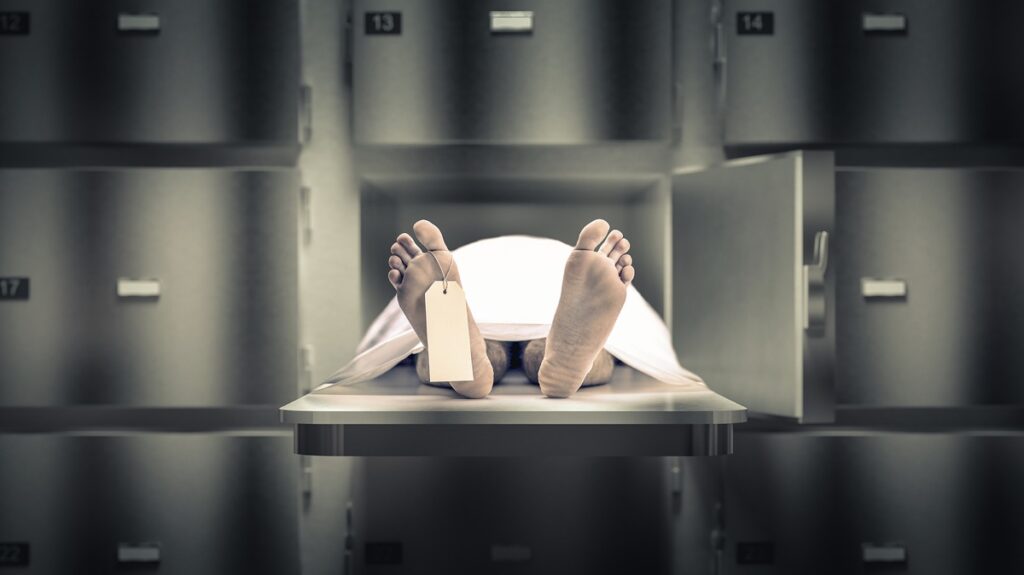When a person dies, their body is sent to a funeral home, and it is prepared for upcoming services and burial or cremation. But have you ever wondered what happens to a dead body at a funeral home? This article will provide insight into the responsibilities of the funeral home and the activities that take place upon arrival and the days that follow until final disposition.
Arrival and sheltering of a body
It is essential first to report the death to the appropriate authorities (e.g., emergency services, family doctor, etc.) and handle time-sensitive needs (e.g., organ donation). Once that is done, families can call the funeral home to pick up the body. Most facilities can do so any time of the day.
Once the body arrives at the facility, it is identified or tagged to ensure there are no mix-ups and sheltered until it is time for funeral-related preparation. Cleaning, disinfecting, and decontamination are also common initial steps upon arrival.
Funeral homes use the term “sheltering” to refer to keeping the body at their facilities. In most cases, refrigeration is used to delay decomposition, which starts immediately after death. However, it is uncommon for final disposition to occur immediately, as specific government paperwork must be completed beforehand, and, in some cases, a coroner may examine the body. Therefore, it is crucial to slow this process down, especially if the individual or their family has chosen a burial.
Most funeral homes used positive temperature refrigeration. Bodies are kept between 2 to 4 C (36 to 39 F), which slows down the decomposition rate but does not stop it completely. Therefore, it is usually kept in that state for no more than two weeks. If the body needs to be preserved for longer, negative temperature refrigeration (-50 to -10 C (-58 to 14 F) can be used. However, most funeral homes do not have the facilities for this.
Embalming can also delay decomposition and may be recommended to preserve the body for services such as a visitation or viewing. However, embalming is not required in Canada regardless of final disposition.
Body preparation
Bodies are sheltered at the facilities throughout the funeral planning process, which means kept in a secure refrigerator at a temperature above freezing. The body will also be prepared for the type of services being held. The two main options for final disposition are burial and cremation. There are two cremation options – flame-based cremation and aquamation. The preparation for these services is discussed below.
Burial of a body
It is common to schedule burials after services such as a viewing or visitation are complete. These services cause the funeral to take up to a week. As such, the body must be prepared, so it does not start to decompose during this time. Refrigeration between services can be used, but funeral staff often recommend embalming, a chemical form of preservation that stalls decomposition. It also allows for the body to be posed for viewing.
Regardless, the preparation begins with the body being cleaned, dressed, and groomed according to the family’s wishes and placed in the casket or coffin. If it is a closed casket service and no one will see the body, not much is done past this point; however, if the body is being viewed, grooming may include keeping the eyes shut with glue or plastic eye caps and wiring or sewing the lower jaw.
What happens to blood?
If embalming has been chosen, blood is removed from the body and replaced with an embalming solution.
The same process will occur with body cavities after being punctured and drained of gas and fluid. Blood and fluids are disposed of through the funeral home’s plumbing system into municipal wastewater.
This is done before dressing and applying makeup to the body. Once this is done, the body is fully embalmed and ready for further preparations.
Embalming is a viable option for open and closed casket ceremonies. It can also be done for those holding services before cremation. However, it is not permitted if the individual is having a green burial, as these services are designed to minimize environmental impact and allow the body to decompose naturally. Similarly, embalming is unnecessary if an individual chooses a direct burial (where the body is buried shortly after death and other pre-burial services are eliminated).
Cremation
Many funeral homes have crematorium facilities on site that will handle this process, but some may send the body to a separate facility. Body preparation for cremation involves removing surgical appliances from the body that should not be exposed to high heat, such as pacemakers which contain a battery and can explode. The resulting remains, which consist mostly of bone, are pulverized into a powder and placed in an urn or container, and returned to the family.
Similar preparation processes mentioned above may also occur if services are held before cremation. Many of these steps can be avoided if direct cremation is chosen.
Flame cremation
With flame-based cremation, everything within the casket will be subject to flames and extreme heat. Therefore, things that families do not want to be destroyed (e.g., jewelry) or pose a health risk to crematorium staff must be removed. This includes artificial or non-organic implants and devices that contain a battery, as they can explode in the cremation chamber. Radioactive implants, such as those used for cancer treatments, must also be removed.
Metal implants such as fillings are not commonly removed (unless done by a dentist) but will not be destroyed in the cremation process. These are removed from the ashes before they are returned to the family. Non-metal implants like breast implants, fillers, and injections are not removed before cremation. They are incinerated.
Aquamation
Unlike flame cremation, implants do not need to be removed for aquamation, as they are not destroyed, and contents are not subject to extreme heat levels. Nonetheless, local regulations may require removal beforehand. For example, The Bereavement Authority of Ontario requires pacemakers and defibrillators to be removed before either type of cremation. The crematorium staff will also remove clothing unless it is protein-based as it is not destroyed during the process.
Final disposition
After the body is prepared, remaining services will take place. With a burial, remaining activities relating to the body involve moving the casket in the viewing or visitation rooms and in and out of refrigeration (if applicable) and transportation to different locations (e.g., cemetery). Staff may also make makeup and staging adjustments.
With cremation, the next step will be to cremate the bodies. These processes are outlined below.
Flame cremation process
After body preparation, the body is placed in a cremation container or kept within the original casket and placed in the cremation chamber or retort. The body is then exposed to temperatures ranging from 760 to 980 Celsius (1400 to 1796 F).
The body is consumed by the heat in the chamber, except for bone and non-combustible materials. The cremated remains are removed from the chamber.
After a cooling period, implants are separated from the cremated remains, usually with a magnet, and are recycled. Remaining bone fragments are mechanically processed into fine particles of dust and placed in a temporary container or cremation urn provided by the family.
Aquamation process
Unlike flame cremation, a casket is not used. Instead, the body is placed in a stainless-steel vessel filled with water and potassium hydroxide (alkali).
The quantity of alkali used depends on body characteristics such as weight and gender, but the ratio for the solution is approximately 95 percent water and five percent alkali.
The vessel’s contents are exposed to high temperatures (200 to 320 F / 93 to 160 C) and agitation to prevent boiling and help break down organic material. During the process, compounds in the body are reduced to basic organic components and dissolved into the water.
By-products from this process are bone fragments and a green-brown liquid that consists primarily of salts. The liquid is released from the vessel as wastewater, and the remains and equipment are rinsed with fresh water. Finally, the bone material gets processed into a powder, placed in an urn, and returned to the family.

